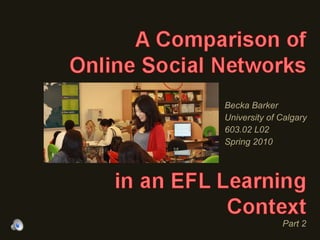
Becka603.02 presentationpart2
- 1. Becka Barker University of Calgary 603.02 L02 Spring 2010 Part 2
- 2. Group Name Social Media Type Description Classes in Each Test Group T 1 Blogger • online journal; dialogue limited • multimodality for authors, but not for comments Native English 1C Native English 1F T 2 Ning • self-contained social network; dialogic forums • multimodality among all network members possible • emphasis on group Native English 1D Native English 1G T 3 Facebook • disparate social network; features a ‘group’ function • emphasis on individual profiles • multimodality between individuals and within groups Native English 1A Native English 1H
- 3. example of a corpus
- 4. Variables will be coded as follows : • total number of linguistic utterances • total number of non-linguistic expressions • total number of paralinguistic expressions • total instances of correct target language use • number of each kind of expression in the first two weeks of test period • number of each kind of expression in the final two weeks of test period • instances of correct target language use in the first two weeks of test period • instances of correct target language use in the final two weeks of test period
- 9. Stommel (2005): “CA investigates social action with a focus on participants’ understanding of one another’s conduct” (p. 3). Belz and Vyatkina (2005): CA of learner-derived corpora may also be used in data-driven learning. Heckman and Annabi (2005): relates CA framework developed for their study to social constructivist learning; learning processes are reflected in communicative utterances Raffaella (1999): “CA originated as an approach to the study of social organization of everyday conduct” (p. 76).
- 10. Herring (2004): the multimodal nature of computer-mediated discourse is socially-driven as well as being technologically-driven and culturally-distinct. Most non-standard features used are deliberate choices by interlocutors, usually to mimic spoken language, economize on typing, or creatively express themselves. Montero, Watts, and García-Carbonell (2007): text-based interaction on computers help with oral proficiency, as well as linguistic and meta-linguistic competence. Raffaella (1999): interpreted paralinguistic features as part of informal online conversation
- 11. Montero, Watts, and García-Carbonell (2007): modals are a common issue for ELLs; modals are also used differently in oral and written contexts Belz and Vyatkina (2005): modals in German language learners’ online conversations were considered representative of pragmatic competence